
Garbage In, Garbage Out: How Small Errors Cause Big Problems in the Supply Chain
In an era dominated by data-driven decisions, data accuracy stands paramount. “Garbage In, Garbage Out” (GIGO) isn’t just a catchy phrase—it’s a reality that can derail strategic business plans.
It isn’t enough to assume that your data is accurate, especially if your data collection practices are outdated. Often, organizations don’t realize they are stockpiling incorrect data values until it’s too late. By then, the data is already in the ERP system, eroding trust in the system and operational efficiency.
The key to preventing low-quality “garbage” data from your ERP environment lies in data collection best practices.
Let’s take a look at how dirty data enters your supply chain database, ways to prevent it from happening, and what best practices are essential to maintaining perfect data collection and 100% inventory accuracy (or as close to it as we can get).
Understanding Data Collection
The Problem: Manual Data Collection Leads to Errors
Despite the massive push for digital transformation in the supply chain in recent years, many warehouses still rely on manual or outdated data collection methods for inventory management.
Manual data collection includes paper-based processes, data entry into spreadsheets, or human memory (“tribal knowledge”). These means of recording inventory updates are inefficient at best—and far from accurate.
Experts estimate that manual data collection can only achieve about 60% accuracy. That leaves a lot of room for error and guesswork. It’s all too easy to misinterpret illegible handwriting after the fact.
Since frontline workers are often the ones using these processes on a daily basis, managers and directors may not realize the problem exists. Meanwhile, frontline workers don’t have access to the entire picture, so they don’t realize the big effects these small inaccuracies create.
Any level of manual processes in data collection impacts the organization negatively. Such as:
- Incorrect inventory levels leading to stock-outs and production delays
- Shipping wrong or late orders
- Rushed reorders, overordering, chargebacks, and unnecessary write-offs
- Extra labor demands and costs
- Reduced profits and customer service
With manual processes, inventory management is slower, lacks visibility, and necessitates extra costs and labor to compensate for bad data in the ERP.
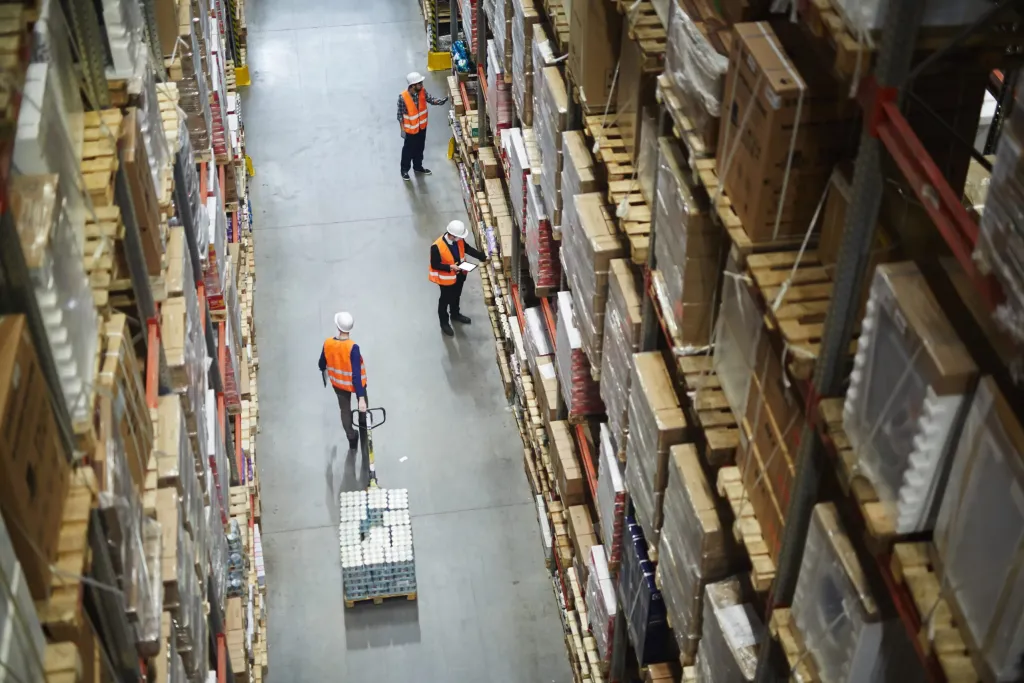
7 Hidden Leaks of Outdated Manual Processes
Case Study: How Errors Occur in Manual Data Collection
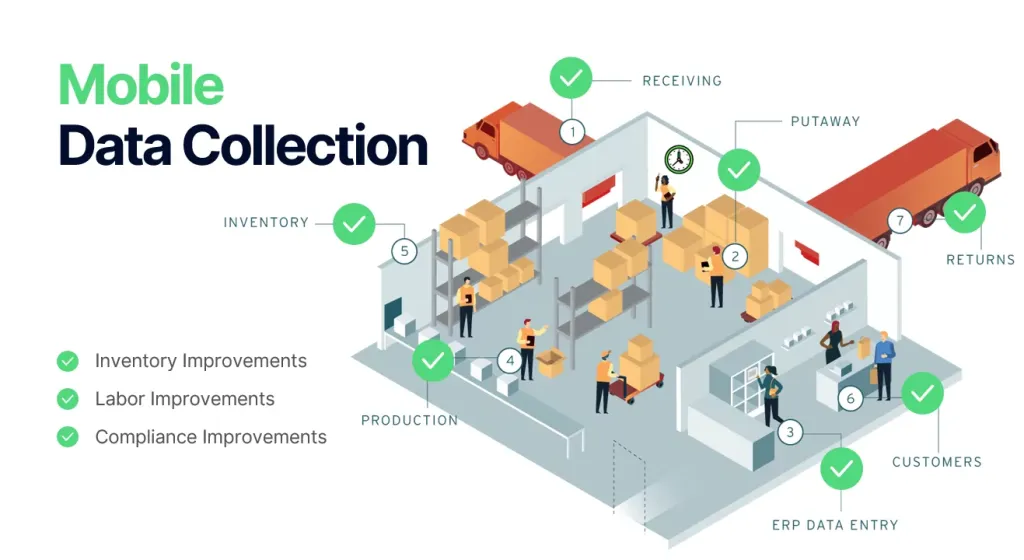
Let’s walk through a normal sequence in the warehouse using manual data collection:
- Your receiving team processes an incoming pallet. Unfortunately, there is a backlog, so the new material sits on the receiving dock for two days. When your receiving clerk finally gets to the shipment, they may hastily scribble down an incorrect item number on the printout before handing it off.
- The receiving clerk then commutes to the workstation, where another clerk takes the paper, incorrectly interprets the handwriting, and incorrectly transposes an item quantity when keying the receiving slip into the ERP.
- Meanwhile, the manager receives a high-priority production order for an important customer. They look in the ERP and find they don’t have the raw materials required.
- Not trusting the system, the manager sends a worker to double-check the physical inventory on the shelves. After an hour, the worker returns empty-handed. (The material is there, but since the ERP doesn’t know that, the team doesn’t know.) The manager rush-orders a new shipment.
- When the rushed order arrives, the manager hurries the pallet to production. The order is completed and delivered. When the order arrives to the customer, it may be late, the contents incorrect, or the label non-compliant.
- Dissatisfied with an incorrect order, the customer returns it with a chargeback, eroding the customer’s trust in your business and cutting into revenue. In the meantime, the missing materials are processed in receiving and put into storage. No longer needed, they turn into a write-off.
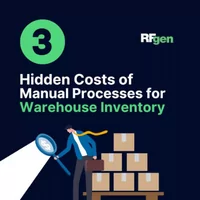
3 Hidden Costs of Manual Processes in the Warehouse
The Solution: Mobile Data Collection Eliminates Errors
Today, mobile data collection is the standard best practice for inventory management. By automating data capture with barcode scanning and mobile apps, you remove opportunities for human error.
A quick barcode scan with a mobile device ensures perfect data collection that updates the ERP in real time. Built-in validations ensure no bad data enters your ERP ecosystem.
Not only does mobile data collection save time, it also makes your warehouse more efficient downstream.
Benefits include:
- 99.9% or higher accuracy
- 30% or more boost to efficiency
- 30% greater worker productivity
- Enhanced visibility and traceability
- Reduced operational costs

Supply Chain Guide to Tracking Inventory Anytime, All the Time
Case Study: Optimization with Mobile Data Collection

Now let’s examine our warehouse workflow using mobile data collection:
- Your receiving team processes an incoming pallet. Since the receiving team scans barcodes from mobile devices to process materials, the received inventory is automatically updated in your ERP. As a result, there is no backlog.
- (Step two is eliminated.)
- Meanwhile, the manager receives a high-priority production order for an important customer. They look in the ERP to find the raw materials needed are sitting at the receiving dock awaiting putaway. This time, they can trust that the inventory is where the ERP says it is. They immediately put the materials into production and send them to the customer. If desired, they can utilize cross-docking to further shorten the process.
- (Step four is eliminated.)
- The order is completed and delivered. When the order arrives to the customer, it is either on-time or early and includes the correct contents, quantities, and compliant labels.
- (Step six is eliminated.)
As a result of using mobile data collection, the manager was able to make an informed, data-driven decision. Her ability to pivot and remain nimble was only possible due to accurate, timely ERP data.
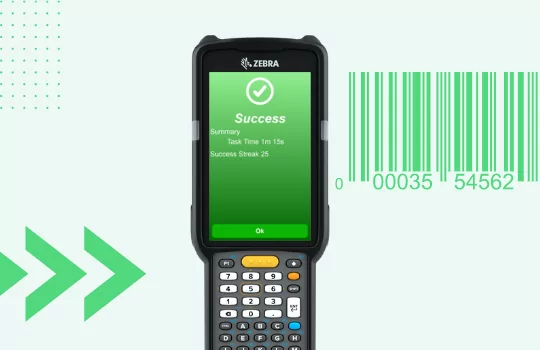
Everything You Need to Know About Mobile Data Collection
The Financial & Operational Impact of Data Errors
Dirty data isn’t just an inconvenience, it has a real, tangible impact on your business. Even a simple error like miskeying a product number can have direct and indirect repercussions.
Direct Consequences
Experts estimate that each inventory error can cost $50-100. Repeated multiple times per day, the costs add up.
Additionally, incorrect data can misinform critical operational decisions, such as production schedules, inventory levels, or order shipments. These mistakes can create inefficiencies and delays, frustrating both employees and customers, not to mention leadership.
Indirect Consequences
Beyond immediate disruptions, data errors can lead to:
- Lack of Agility: Inability to pivot in the face of the unexpected exacerbates cost and labor burden. Agility is crucial in today’s fast-paced supply chain.
- Eroded Trust: Consistent mistakes erode customer confidence. Imagine receiving a wrong order repeatedly or facing consistent delivery delays. Would you trust such a business again?
- Environmental Impacts: Inefficient processes lead to waste. Overproduction, product returns, and increased transportation—all due to data errors—contribute to a larger carbon footprint.
Transitioning to Modern Data Collection Methods
As we’ve seen, holding on to outdated data collection practices is costly and ineffective. Obsolete barcode software may boost accuracy to a point but lacks the flexibility and advanced capabilities offered by modern solutions like mobile barcoding.
Today’s enterprise mobility solutions extend the power of your ERP system to point-of-work. RFgen takes this functionality to the next level, providing major improvements in nearly all KPI areas while simultaneously reducing costs.
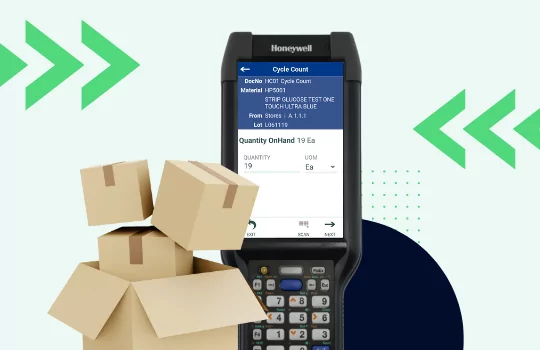
The Comprehensive Guide to Mobile Inventory Solutions
Industry Trends
In terms of data collection, the future holds a plethora of emerging and maturing technologies. Some of these data collection trends include:
- RFID: Radio Frequency Identification devices have been in use for many years. By affixing RFID tags to high-value inventory, these items can be tracked in real time without human intervention.
- IoT: Devices interconnected through the Internet of Things (IoT) can communicate important data, like temperatures and weights. RFgen includes IoT data collection capabilities.
- AI: Artificial Intelligence can predict patterns, offer insights, and even correct minor errors, ensuring smoother operations. The use of AI is quickly expanding in the supply chain.
- Blockchain: For supply chains, blockchain offers a secure, transparent, and immutable ledger, ensuring that data once entered can’t be tampered with, guaranteeing its authenticity.
Training & Transition Challenges
Change is seldom easy, but having the right mobile data collection software partner can go a long way to ensure a smooth implementation, simple training, and maximum user adoption.
For instance, RFgen’s senior ERP consultants go above and beyond to ensure project success. With a proven track record of 100% successful implementations, having the right people in place on a mobile project can be make or break.
Cost-Benefit Analysis (ROI)
Initial investments in mobile technology may seem high at first. However, when weighed against long-term benefits and savings, the ROI becomes evident. In the end, the benefits tend to far outweigh the initial cost.
When conducting your own cost-benefit analysis, consider the impact of the following:
- Fewer errors, delays, and bottlenecks
- Greater operational efficiency and product quality
- Long-term cost savings, profitability
- Scalability of operations
- Enhanced customer service
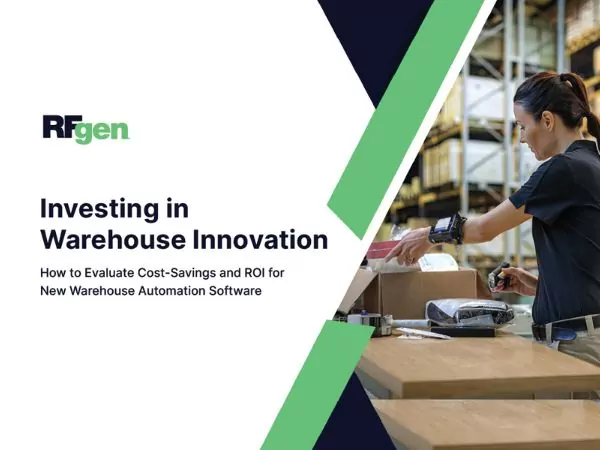
Investing in Warehouse Innovation: How to Calculate ROI
Quality In, Quality Out with Mobile Data Collection
Modern supply chains run on data. Without quality data to fuel your ERP system, your organization can’t make confident strategic decisions. Modernizing data collection with mobile barcoding is no longer a luxury, but an imperative to efficient operations. Don’t let “garbage” data into your ERP. Instead, ensure perfect accuracy and clear visibility while reducing overhead waste. With that foundation in place, it becomes possible to grow your business at scale.







